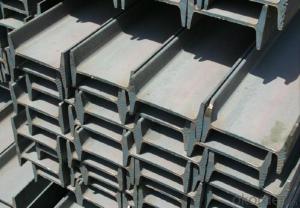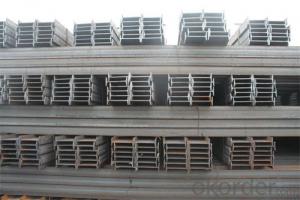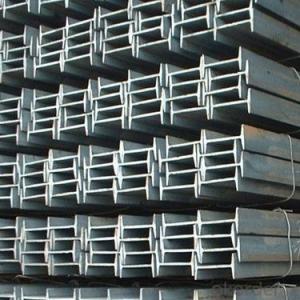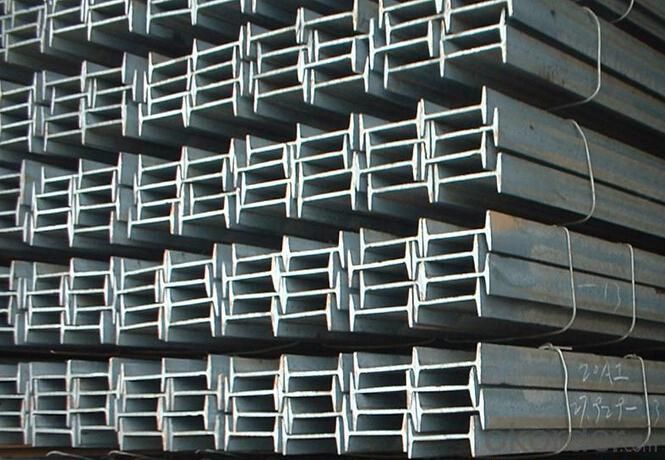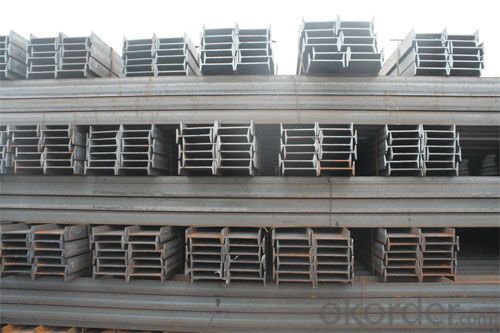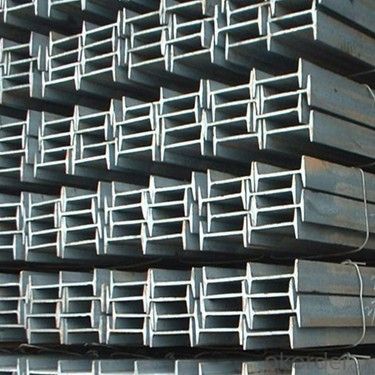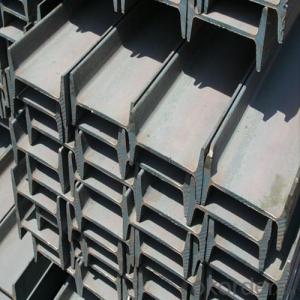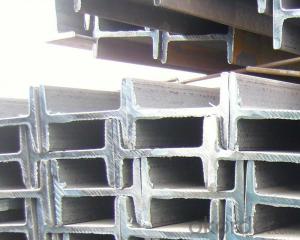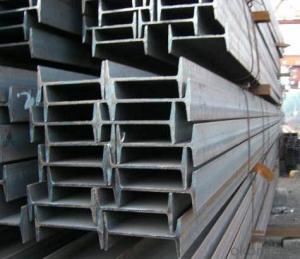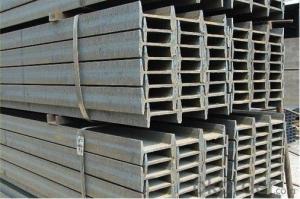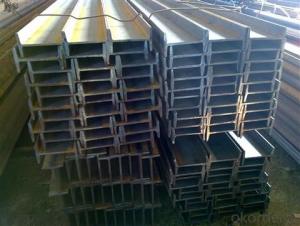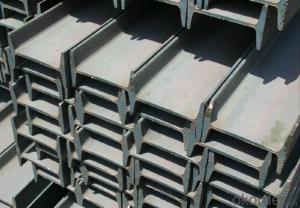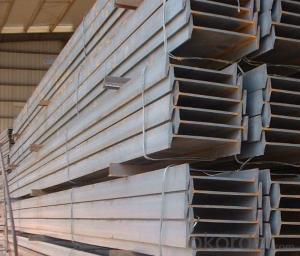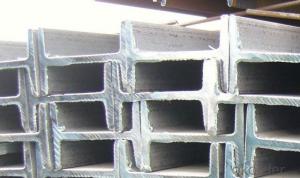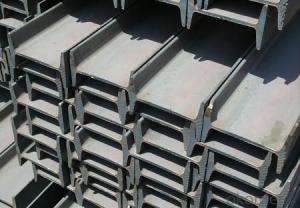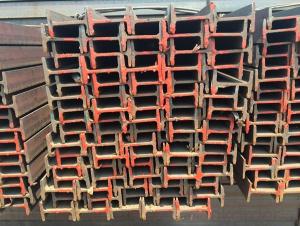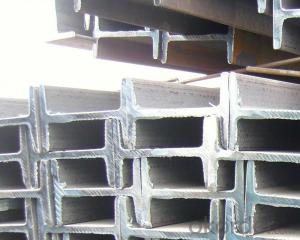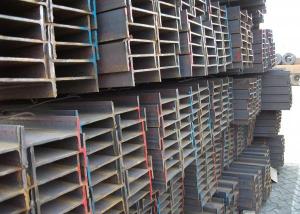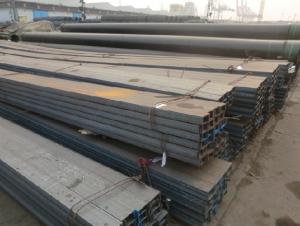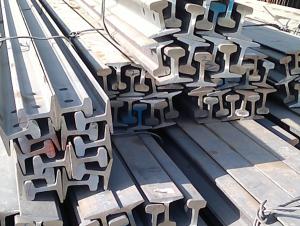Hot Rolled Steel of Q235B IPEAA80 for Construction Steel I-Beams
- Loading Port:
- Tianjin
- Payment Terms:
- TT or LC
- Min Order Qty:
- 25 m.t.
- Supply Capability:
- 100000 m.t./month
OKorder Service Pledge
OKorder Financial Service
You Might Also Like
OKorder is offering high quality Hot Rolled Steel I-Beams at great prices with worldwide shipping. Our supplier is a world-class manufacturer of steel, with our products utilized the world over. OKorder annually supplies products to European, North American and Asian markets. We provide quotations within 24 hours of receiving an inquiry and guarantee competitive prices.
Product Applications:
1. Supporting members, most commonly in the house raising industry to strengthen timber bears under houses. Transmission line towers, etc
2. Prefabricated structure
3. Medium scale bridges
4. It is widely used in various building structures and engineering structures such as roof beams, bridges, transmission towers, hoisting machinery and transport machinery, ships, industrial furnaces, reaction tower, container frame and warehouse etc.
Product Advantages:
OKorder's Steel I-Beams are durable, strong, and resist corrosion.
OKorder is offering high quality Hot Rolled Steel I-Beams at great prices with worldwide shipping. Our supplier is a world-class manufacturer of steel, with our products utilized the world over. OKorder annually supplies products to European, North American and Asian markets. We provide quotations within 24 hours of receiving an inquiry and guarantee competitive prices.
Product Applications:
1. Supporting members, most commonly in the house raising industry to strengthen timber bears under houses. Transmission line towers, etc
2. Prefabricated structure
3. Medium scale bridges
4. It is widely used in various building structures and engineering structures such as roof beams, bridges, transmission towers, hoisting machinery and transport machinery, ships, industrial furnaces, reaction tower, container frame and warehouse etc.
OKorder is offering high quality Hot Rolled Steel I-Beams at great prices with worldwide shipping. Our supplier is a world-class manufacturer of steel, with our products utilized the world over. OKorder annually supplies products to European, North American and Asian markets. We provide quotations within 24 hours of receiving an inquiry and guarantee competitive prices.
Product Applications:
1. Supporting members, most commonly in the house raising industry to strengthen timber bears under houses. Transmission line towers, etc
2. Prefabricated structure
3. Medium scale bridges
4. It is widely used in various building structures and engineering structures such as roof beams, bridges, transmission towers, hoisting machinery and transport machinery, ships, industrial furnaces, reaction tower, container frame and warehouse etc.
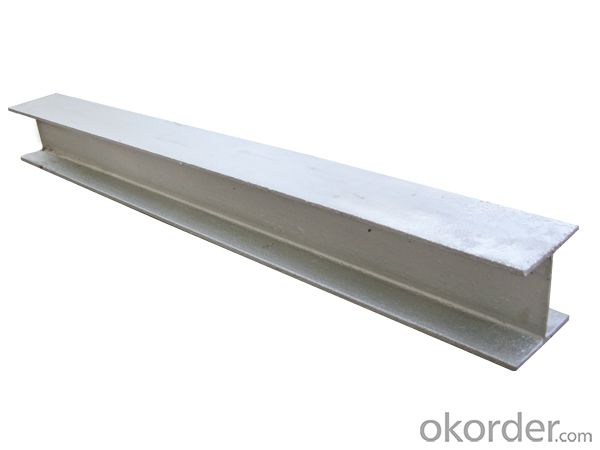

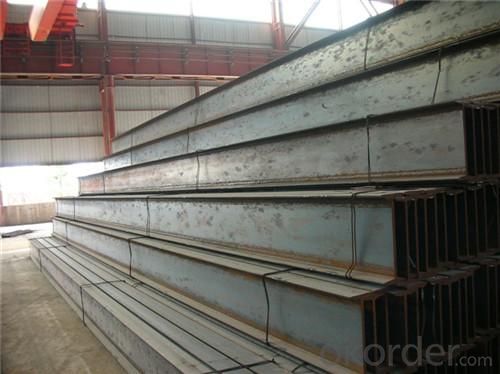
- Q: What are the transportation and handling considerations for steel I-beams?
- To guarantee the safety of both the materials and those involved, it is vital to take into account certain factors regarding the transportation and handling of steel I-beams. Here are some key points to bear in mind: 1. Equipment: The transportation of steel I-beams necessitates the use of specialized equipment due to their weight. Cranes, forklifts, or other lifting devices should be employed for safe handling and movement. It is imperative to ensure that the equipment chosen is suitable for the weight and size of the beams. 2. Secure Packaging: Proper packaging and securing of steel I-beams are essential to prevent damage during transportation. The beams should receive adequate wrapping, strapping, or securing to prevent any shifting, rolling, or falling while in transit. This safeguards the beams against scratches, dents, or any other physical damage. 3. Weight Distribution: When loading steel I-beams onto a truck or any other transport means, it is crucial to distribute the weight evenly. Uneven weight distribution can lead to instability during transportation, potentially resulting in accidents or damage to the beams. 4. Handling Precautions: Caution should be exercised when handling steel I-beams to prevent injuries. Workers should undergo training on correct lifting techniques and wear appropriate personal protective equipment (PPE) like gloves, safety boots, and helmets. It is also advisable to have a team of trained individuals to aid in the handling process. 5. Route Planning: Prior to transporting steel I-beams, meticulous route planning is necessary. Factors such as road conditions, weight limits of bridges, and height restrictions must be taken into consideration to ensure a smooth and safe journey. In some instances, it may be imperative to obtain permits or escorts in order to comply with local regulations. 6. Weather Conditions: Weather conditions can impact the transportation and handling of steel I-beams. Extreme weather conditions like strong winds, heavy rain, or snow can pose additional risks. It is crucial to monitor weather forecasts and make necessary adjustments to the transportation plan in order to minimize potential hazards. 7. Storage: If temporary storage of steel I-beams is required, it is crucial to keep them in a clean, dry, and well-ventilated area. Storing them on a flat surface, preferably on wooden or rubber blocks, can help prevent damage from moisture, rust, or contact with the ground. By taking these transportation and handling considerations into account, the risk of damage, accidents, and injuries can be minimized, ensuring the safe delivery and utilization of steel I-beams.
- Q: What are the common methods of installing steel I-beams in existing structures?
- There are several common methods used for installing steel I-beams in existing structures. These methods depend on the specific circumstances and requirements of the project. Here are some of the most commonly employed methods: 1. Temporary Support: Before the installation of the steel I-beam, temporary supports are often put in place to ensure the stability and safety of the structure during the installation process. This typically involves using hydraulic jacks or steel shoring to provide temporary support to the existing structure. 2. Cutting and Removal: In some cases, a section of the existing structure needs to be cut and removed to make space for the steel I-beam. This is commonly done using specialized cutting tools such as oxy-acetylene torches or reciprocating saws. Once the necessary space is created, the steel I-beam can be installed. 3. Crane or Rigging: For larger and heavier steel I-beams, a crane or rigging system is often used to lift and position the beam into place. This method requires careful planning and coordination to ensure the safety of the workers and the stability of the structure. 4. Welding or Bolting: Once the steel I-beam is properly positioned, it is typically secured to the existing structure using either welding or bolting. Welding involves fusing the steel I-beam to the surrounding structure using specialized welding techniques. Bolting, on the other hand, involves using high-strength bolts to secure the beam in place. 5. Reinforcement: In some cases, additional reinforcement may be required to ensure the structural integrity of the existing structure. This can involve adding additional steel plates, braces, or other support elements to strengthen the connection between the steel I-beam and the existing structure. It is important to note that the specific method used for installing steel I-beams in existing structures may vary depending on factors such as the size and weight of the beam, the condition of the existing structure, and the expertise of the construction team. Therefore, it is crucial to consult with a structural engineer or a qualified construction professional to determine the most appropriate method for a specific project.
- Q: Can steel I-beams be used in industrial facilities?
- Yes, steel I-beams can be used in industrial facilities. Steel I-beams are commonly used in the construction of industrial buildings and facilities due to their strength, durability, and versatility. They are capable of supporting heavy loads and providing structural stability, making them ideal for industrial applications where large machinery, equipment, and materials need to be supported. Additionally, steel I-beams can be easily fabricated and customized to meet the specific needs and requirements of an industrial facility, making them a popular choice in the construction industry.
- Q: Are there any environmental concerns associated with using steel I-beams?
- Yes, there are several environmental concerns associated with using steel I-beams. Firstly, the production of steel involves the extraction of iron ore, which can lead to significant habitat destruction and deforestation. Mining activities can also contribute to soil erosion and water pollution, impacting local ecosystems and wildlife. Additionally, the manufacturing process for steel involves high energy consumption and greenhouse gas emissions. Steel production is a major contributor to global carbon dioxide emissions, which are a leading cause of climate change. The extraction, transportation, and processing of raw materials required for steel production also consume large amounts of fossil fuels, further exacerbating the carbon footprint. Moreover, steel production requires large quantities of water, which can strain local water resources, particularly in areas already facing water scarcity. The disposal of waste materials, such as slag and dust, generated during the steel manufacturing process can also pose environmental challenges. Lastly, steel is a non-renewable resource, meaning it is not replenished naturally within a human timescale. As a result, the increasing demand for steel can contribute to resource depletion and the need for further mining and extraction, perpetuating the negative environmental impacts associated with its production. To mitigate these environmental concerns, efforts have been made to improve the sustainability of steel production. This includes adopting cleaner production technologies, such as recycling scrap steel and using electric arc furnaces, which can significantly reduce energy consumption and emissions. Using recycled steel reduces the need for new extraction and processing, conserving resources and minimizing environmental impacts. Additionally, incorporating renewable energy sources into the steel production process can help reduce greenhouse gas emissions. Overall, while steel I-beams are widely used in construction due to their strength and durability, it is essential to consider and address the environmental concerns associated with their production and use to promote a more sustainable built environment.
- Q: What are the common methods of reinforcing steel I-beams for increased load capacity?
- There are several common methods used to reinforce steel I-beams for increased load capacity. These methods include: 1. Adding additional steel plates: One of the most straightforward ways to reinforce an I-beam is by adding additional steel plates to its flanges or web. These plates are typically welded or bolted to the existing beam, increasing its strength and load-bearing capacity. 2. Flange strengthening: Another method involves strengthening the flanges of the I-beam by attaching steel angles or channels to them. These additional sections distribute the load over a larger area, reducing stress concentrations and increasing the beam's capacity. 3. Web stiffeners: To enhance the load capacity of the I-beam, web stiffeners can be installed along the web of the beam. These stiffeners are usually made of steel plates or angles and are welded to the web at regular intervals. They help prevent buckling and provide additional support to the beam under heavy loads. 4. Composite reinforcement: Another effective method is using composite materials to reinforce the I-beam. Carbon fiber reinforced polymer (CFRP) sheets or strips can be bonded to the beam's flanges or web. This technique increases the beam's strength and stiffness, allowing it to carry higher loads. 5. Steel plates with holes: By adding steel plates with holes to the I-beam, the load capacity can be increased. These plates are typically bolted to the beam, and the holes allow for easy adjustment and flexibility in load distribution. It is important to note that the choice of reinforcement method depends on the specific requirements of the project, including the load capacity needed, the existing condition of the I-beam, and the available resources. Consulting with a structural engineer or professional is recommended to determine the most suitable reinforcement method for a particular application.
- Q: What are the considerations for thermal insulation when using steel I-beams?
- When utilizing steel I-beams, there are several factors to consider in terms of thermal insulation. 1. Steel Conductivity: Steel possesses high conductivity, meaning it has the ability to transfer heat rapidly. This can result in significant heat loss or gain through the steel I-beams, depending on the temperature difference between the building's interior and exterior. Therefore, it is crucial to select insulation materials with low thermal conductivity to minimize heat transfer through the steel beams. 2. Compliance with Building Codes: It is imperative to adhere to local building codes and regulations regarding thermal insulation requirements. These codes often specify minimum thermal resistance (R-value) or U-value requirements that must be met to ensure energy efficiency and occupant comfort. The choice of insulation for steel I-beams should meet or exceed these requirements. 3. Proper Insulation Placement: Optimal placement of insulation is vital to maximize thermal efficiency. Insulating the exterior side of the steel I-beams aids in preventing thermal bridging, which occurs when heat bypasses the insulation through the steel beams, resulting in energy loss. Insulation can also be positioned between the flanges and web of the I-beams to further enhance thermal performance. 4. Effective Moisture Management: Steel I-beams have the potential to condense moisture due to temperature differences between the building's interior and exterior. This moisture can lead to corrosion and diminish the effectiveness of the insulation. Therefore, it is important to incorporate moisture barriers or vapor retarders to prevent moisture infiltration and manage vapor diffusion. 5. Ensuring Fire Safety: Although steel is a non-combustible material, it can lose strength at high temperatures. Hence, it is crucial to select insulation materials with excellent fire resistance properties to safeguard the steel I-beams in the event of a fire. Fire-rated insulation options should be considered to ensure the overall safety of the structure. 6. Structural Considerations: Adding insulation may increase the thickness or alter the dimensions of the steel I-beams, which can have implications for structural design. It is vital to consult with structural engineers to ensure that the insulation does not compromise the load-bearing capacity or integrity of the steel I-beams. To summarize, when using steel I-beams, it is important to consider minimizing thermal conductivity, complying with building codes and regulations, proper insulation placement, effective moisture management, ensuring fire safety, and accounting for structural implications. By addressing these considerations, the thermal performance of a building can be optimized, resulting in improved energy efficiency and occupant comfort.
- Q: Can steel I-beams be used in the construction of office buildings?
- Yes, steel I-beams can be used in the construction of office buildings. Steel I-beams are commonly used as structural support elements in various types of buildings, including office buildings. They are known for their strength, durability, and load-bearing capacity, making them suitable for supporting the weight of the floors, walls, and roof of an office building. Steel I-beams are often used in the construction of skyscrapers, where their ability to withstand heavy loads and provide long-span support is crucial. Additionally, steel I-beams offer flexibility in design and can be easily integrated into the overall architectural layout of an office building. Their use in construction also allows for faster construction times and reduced costs compared to other structural materials. Overall, steel I-beams are a popular choice in the construction of office buildings due to their strength, reliability, and versatility.
- Q: What is the moment of inertia and the moment of resistance of section No. 16 for I-beam?
- I-beam is also called steel girder (English name Universal Beam). It is a strip of steel with an I-shaped section. I-beam is divided into ordinary I-beam and light I-beam, H steel three. It is a section steel whose shape is trough.
- Q: How are steel I-beams protected against galvanic corrosion?
- Galvanic corrosion is prevented in steel I-beams through galvanization. This process involves adding a layer of zinc to the surface of the steel beam. Typically, the steel beam is dipped in molten zinc in a hot-dip galvanizing process. The zinc bonds with the steel, creating a barrier that shields it from corrosion. The zinc coating acts as a sacrificial anode, meaning it corrodes before the steel when exposed to corrosive elements. This sacrificial corrosion of the zinc prevents the steel from being exposed to corrosive agents, thus extending the lifespan of the steel I-beam. Additionally, the zinc coating acts as a physical barrier, preventing moisture, oxygen, and other corrosive substances from reaching the steel surface. The thickness of the zinc coating can vary depending on the required level of protection. Thicker coatings are commonly used in highly corrosive environments, while thinner coatings may suffice for less aggressive conditions. Regular inspection and maintenance of the zinc coating, such as removing accumulated dirt or debris, are also crucial to ensure its effectiveness in preventing galvanic corrosion. In conclusion, steel I-beams are safeguarded against galvanic corrosion by applying a zinc coating through galvanization. This protective layer functions as a sacrificial anode, corroding instead of the steel and preventing corrosive agents from reaching the steel surface. Ongoing maintenance and inspection of the zinc coating are vital to guarantee its long-term effectiveness in preventing galvanic corrosion.
- Q: What are the different types of steel reinforcements for I-beams?
- I-beams can be reinforced using various types of steel, each possessing unique characteristics and advantages. Hot-rolled steel, for instance, is a commonly used reinforcement. To manufacture this type of reinforcement, the steel billet or ingot is heated to high temperatures and then rolled into the desired shape. Known for their exceptional strength and durability, hot-rolled steel reinforcements are ideal for heavy-duty applications like constructing bridges and high-rise buildings. Another popular option for reinforcing I-beams is cold-formed steel. This type of reinforcement is created by bending or shaping cold steel sheets or strips into the desired form. Cold-formed steel reinforcements are frequently utilized in light structural applications, such as residential construction, due to their cost-effectiveness and ease of fabrication. Apart from hot-rolled and cold-formed steel reinforcements, there are also specialized types available. For instance, stainless steel reinforcements are often employed in environments where corrosion resistance is crucial, such as coastal areas or chemical plants. Additionally, carbon steel reinforcements are widely used in numerous applications due to their affordability and high strength. It is important to note that the choice of steel reinforcement for I-beams depends on several factors, including structural requirements, load-bearing capacity, and environmental conditions. Engineers and architects carefully consider these factors when selecting the appropriate type of steel reinforcement to ensure the safety and longevity of the structure.
Send your message to us
Hot Rolled Steel of Q235B IPEAA80 for Construction Steel I-Beams
- Loading Port:
- Tianjin
- Payment Terms:
- TT or LC
- Min Order Qty:
- 25 m.t.
- Supply Capability:
- 100000 m.t./month
OKorder Service Pledge
OKorder Financial Service
Similar products
Hot products
Hot Searches
Related keywords

